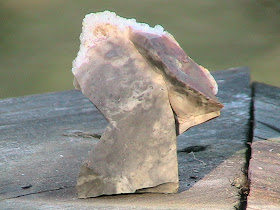Human head in left profile. The flake was found by Dennis Boggs, Boardman, Oregon, in the valley floor potato fields growing right alongside the Columbia River near Irrigon. The location is about 45 miles downriver from Kennewick, WA.
Side 1 again. Click to expand, this is a nice photo. Forehead, eye, nose, mouth, chin all seem to be present in micro-carving. Click photo to expand. The photo left side of the flake as shown here has been worked to take advantage of the translucence of the flint. Shown above with morning light streaming from behind. The left edge of the flint has been re-touched by the artist to refine the facial features. The features are highlighted when one holds the flake up to low angle sunlight.
 Side 2 with natural morning sunlight illuminating from behind. It depicts a face in right profile view. A small incised line makes for a mouth in the bottom right of the artifact here, the dark spot is maybe a nose, right eye in center, part of left eye seen on other side of the nose on edge of artifact.
Side 2 with natural morning sunlight illuminating from behind. It depicts a face in right profile view. A small incised line makes for a mouth in the bottom right of the artifact here, the dark spot is maybe a nose, right eye in center, part of left eye seen on other side of the nose on edge of artifact.
Side 2, artifact on a 1cm grid to provide scale
 Right eye has been ground into the cortex surface. It is located in the center of the artifact here and the left eye is on the screen right edge of the flint looking like a crescent shaped gouge. Because of the left facial profile view presented by the artist, the left eye is seen only in part because it is partially hidden by the nose. This seems to be a rather complex visual technique for the artist to accomplish. Most all of the flint observable here is the rind from the original stone cortex- weather battered except for the two eye holes and an incision for a mouth. Side 2 is from inside the core.
Right eye has been ground into the cortex surface. It is located in the center of the artifact here and the left eye is on the screen right edge of the flint looking like a crescent shaped gouge. Because of the left facial profile view presented by the artist, the left eye is seen only in part because it is partially hidden by the nose. This seems to be a rather complex visual technique for the artist to accomplish. Most all of the flint observable here is the rind from the original stone cortex- weather battered except for the two eye holes and an incision for a mouth. Side 2 is from inside the core.
Side 2 as back lighted as a lithophane
Side 1, artifact as back lit in a dark room as a "lithophane."
Side 1, inside the cortex exposed by this flake removal were some beautiful crystal formations. Artifact on centimeter(cm) grid for scale. The flint fractures here appear to be well-weathered which attests to some combination of time and abrasive environmental forces acting on the piece. All the crystal formations look like brains inside the head or maybe head hair.
 This whole flint nodule, not just a flake made off one, is of the same material as the flake art piece and shows a precedent for making facial icons out of this beautiful orange/red translucent lithic material in the locale of the Columbia River, Irrigon, Oregon. A similar grinding technique was used to create all four eyes on the two figure stones.
This whole flint nodule, not just a flake made off one, is of the same material as the flake art piece and shows a precedent for making facial icons out of this beautiful orange/red translucent lithic material in the locale of the Columbia River, Irrigon, Oregon. A similar grinding technique was used to create all four eyes on the two figure stones. Another earlier posting of a human head left profile utilizing translucent material, from L Jimmy Groen of The Netherlands.Artifact from Neanderthal strata ca. 45,000 to 55,000 years BP from L Jimmy Groen, stone tools expert from The Netherlands. Ken Johnston detected what could be a human facial profile in the translucent material, Neanderthal in nature, and then it was confirmed the find context and site dating made it entirely possible.
Another earlier posting of a human head left profile utilizing translucent material, from L Jimmy Groen of The Netherlands.Artifact from Neanderthal strata ca. 45,000 to 55,000 years BP from L Jimmy Groen, stone tools expert from The Netherlands. Ken Johnston detected what could be a human facial profile in the translucent material, Neanderthal in nature, and then it was confirmed the find context and site dating made it entirely possible.












































